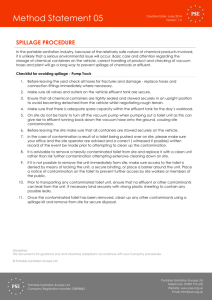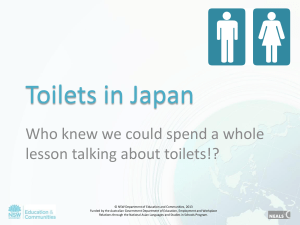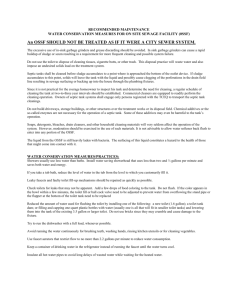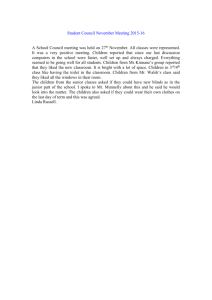portable toilet servicing and maintenance procedures
advertisement
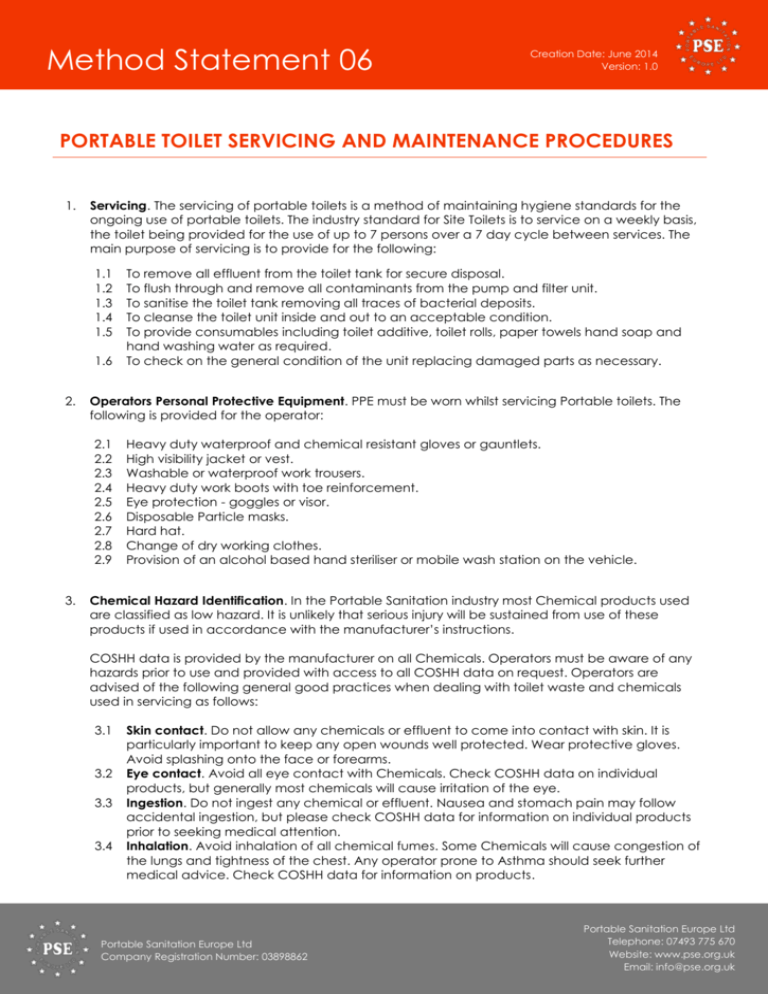
Method Statement 06 Creation Date: June 2014 Version: 1.0 PORTABLE TOILET SERVICING AND MAINTENANCE PROCEDURES 1. Servicing. The servicing of portable toilets is a method of maintaining hygiene standards for the ongoing use of portable toilets. The industry standard for Site Toilets is to service on a weekly basis, the toilet being provided for the use of up to 7 persons over a 7 day cycle between services. The main purpose of servicing is to provide for the following: 1.1 1.2 1.3 1.4 1.5 1.6 2. Operators Personal Protective Equipment. PPE must be worn whilst servicing Portable toilets. The following is provided for the operator: 2.1 2.2 2.3 2.4 2.5 2.6 2.7 2.8 2.9 3. To remove all effluent from the toilet tank for secure disposal. To flush through and remove all contaminants from the pump and filter unit. To sanitise the toilet tank removing all traces of bacterial deposits. To cleanse the toilet unit inside and out to an acceptable condition. To provide consumables including toilet additive, toilet rolls, paper towels hand soap and hand washing water as required. To check on the general condition of the unit replacing damaged parts as necessary. Heavy duty waterproof and chemical resistant gloves or gauntlets. High visibility jacket or vest. Washable or waterproof work trousers. Heavy duty work boots with toe reinforcement. Eye protection - goggles or visor. Disposable Particle masks. Hard hat. Change of dry working clothes. Provision of an alcohol based hand steriliser or mobile wash station on the vehicle. Chemical Hazard Identification. In the Portable Sanitation industry most Chemical products used are classified as low hazard. It is unlikely that serious injury will be sustained from use of these products if used in accordance with the manufacturer’s instructions. COSHH data is provided by the manufacturer on all Chemicals. Operators must be aware of any hazards prior to use and provided with access to all COSHH data on request. Operators are advised of the following general good practices when dealing with toilet waste and chemicals used in servicing as follows: 3.1 3.2 3.3 3.4 Skin contact. Do not allow any chemicals or effluent to come into contact with skin. It is particularly important to keep any open wounds well protected. Wear protective gloves. Avoid splashing onto the face or forearms. Eye contact. Avoid all eye contact with Chemicals. Check COSHH data on individual products, but generally most chemicals will cause irritation of the eye. Ingestion. Do not ingest any chemical or effluent. Nausea and stomach pain may follow accidental ingestion, but please check COSHH data for information on individual products prior to seeking medical attention. Inhalation. Avoid inhalation of all chemical fumes. Some Chemicals will cause congestion of the lungs and tightness of the chest. Any operator prone to Asthma should seek further medical advice. Check COSHH data for information on products. Portable Sanitation Europe Ltd Company Registration Number: 03898862 Portable Sanitation Europe Ltd Telephone: 07493 775 670 Website: www.pse.org.uk Email: info@pse.org.uk Method Statement 06 3.5 3.6 4. Site hazards. Do not allow access to the toilet unit or service area during servicing by anyone other than the operator owing to the hazards of moving machinery parts on the pump unit, risk to third parties through personal contact or inhalation of chemicals or effluent contamination. Chemical contamination. In all cases of chemical contamination seek immediate medical advice. Make available to the medical team the name of the chemical involved, the manufacturers address or telephone number for advice and COSHH information. Contact details will be found on all containers, or via the supplying Company head office. Service Procedure. 4.1 4.2 4.3 4.4 4.5 4.6 4.7 4.8 5. Creation Date: June 2014 Version: 1.0 Remove all effluent deposits from the toilet tank. If the tank is discoloured or there is an unacceptable odour, then bacteria deposits are likely to have formed and will need removing. Use a descaler or sanitiser to effect removal of bacteria, lime scale and urine salt deposits. Apply to the inside of the tank, toilet bowel, urinal and any other surface where contamination is detected. Allow to soak. Brush vigorously using a nylon head brush. Rinse thoroughly with clean water. Remove resultant residue. Place the toilet filter a bucket of fresh water. Close the lid and operate toilet pump until flushing clear to remove all contaminants in the pump and filter assembly. Flush the tank with clean water. Remove all remaining waste from tank. When the tank is thoroughly clean add the toilet additive. For best results administer the toilet additive before charging with fresh water to ensure better dispersion of the chemical. Add 20 litres of fresh clean water and ensure solution is thoroughly mixed. Operate the toilet pump to draw the mixture through the pump. Do not allow any other chemical agent or water from the cleaning process to enter the tank once the toilet is recharged with toilet additive and fresh water. Remove any graffiti, tar and cement deposits with appropriate chemical cleaners. Wash down all interior and exterior surfaces of the toilet unit using a diluted hard surface cleaner in accordance with manufacturer’s instructions. Rinse if necessary. Dry as required. Scrub the floor clean and rinse with fresh water. Refill the sink unit with fresh water if appropriate. Replenish paper products and hand soap. Finally spray odour control inside toilet unit by means of a hand held spray to leave toilet smelling fresh and clean. Fill in company service record as required. General Advice. 5.1 5.2 5.3 5.4 To avoid possible chemical spillage drive slowly and carefully over rough ground. Do not allow access to the toilet unit or vehicle during servicing by anyone other than the pump truck operator owing to the hazards of moving machinery parts, chemical or effluent contamination through personal contact. If access to the toilet unit is impaired always advise the Site Manager that access to service is not practicable. Provide him with the opportunity to improve access so that servicing may be completed. Contact your head office for further advice if necessary. It is vital that all empty chemical containers and other contaminated materials are returned to the yard for correct disposal. Portable Sanitation Europe Ltd Company Registration Number: 03898862 Portable Sanitation Europe Ltd Telephone: 07493 775 670 Website: www.pse.org.uk Email: info@pse.org.uk Method Statement 06 6. Chemical Spillage. 6.1 7. Creation Date: June 2014 Version: 1.0 For minor spillage within the toilet unit or on the vehicle, it may be possible to flush contaminants to foul sewer, using copious amounts of clean water. If necessary first absorb any excess contamination by suitable means and remove from site in a plastic container for disposal at an approved site. Pump Truck check list for avoiding spillage. 7.1 7.2 7.3 7.4 7.5 7.6 7.7 7.8 7.9 7.10 Before leaving the yard check all hoses for fractures and damage - replace hoses and connection fittings immediately where necessary. Make sure all valves/outlets on the vehicle effluent tank are secure. Ensure that all chemical containers are tightly sealed and stowed securely in an upright position to avoid becoming detached from the vehicle whilst negotiating rough terrain. Make sure there is adequate spare capacity within the effluent tank for the day’s work load. On site do not be hasty to turn off the vacuum pump when pumping out a toilet unit as this can give rise to effluent running back down the vacuum hose onto the ground, causing site contamination. Before leaving the site make sure that all containers are stowed securely on the vehicle. In the case of contamination as result of a toilet being pushed over on site please make sure your office and the site operator is advised. Remove a heavily contaminated toilet from site and replace it with a clean unit rather than risk further contamination attempting extensive cleaning down on site. If it is not possible to remove the unit immediately from site, make sure access to the toilet is denied by means of locking the unit, a secure binding, or place a barrier around the unit. Place a notice of contamination on the toilet to prevent further access by site workers or members of the public. Prior to transporting any contaminated toilet unit, ensure that no effluent or other contaminants can leak from the unit. Once the contaminated toilet has been removed, clean up any other contaminants and remove from site for secure disposal. Please use instructions for servicing of toilet units in conjunction with the PSE National Sanitation Qualification Training Scheme. Disclaimer: This document is for guidance only and should be adapted in accordance with your Company procedures. © Portable Sanitation Europe Ltd Portable Sanitation Europe Ltd Company Registration Number: 03898862 Portable Sanitation Europe Ltd Telephone: 07493 775 670 Website: www.pse.org.uk Email: info@pse.org.uk
